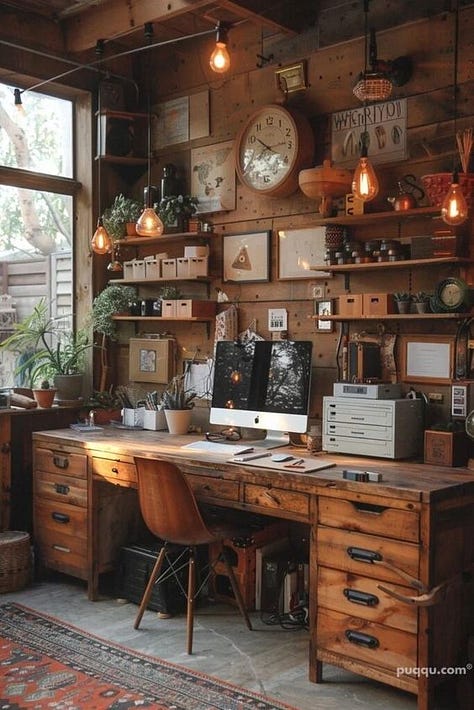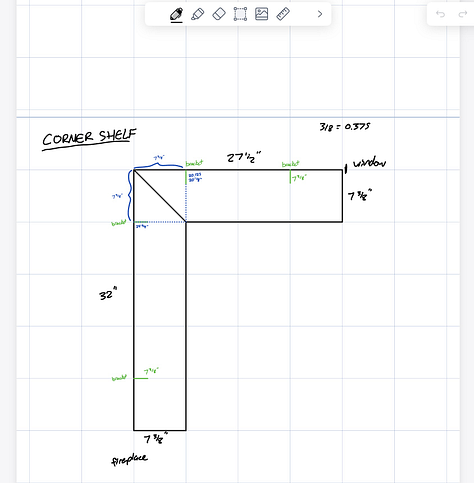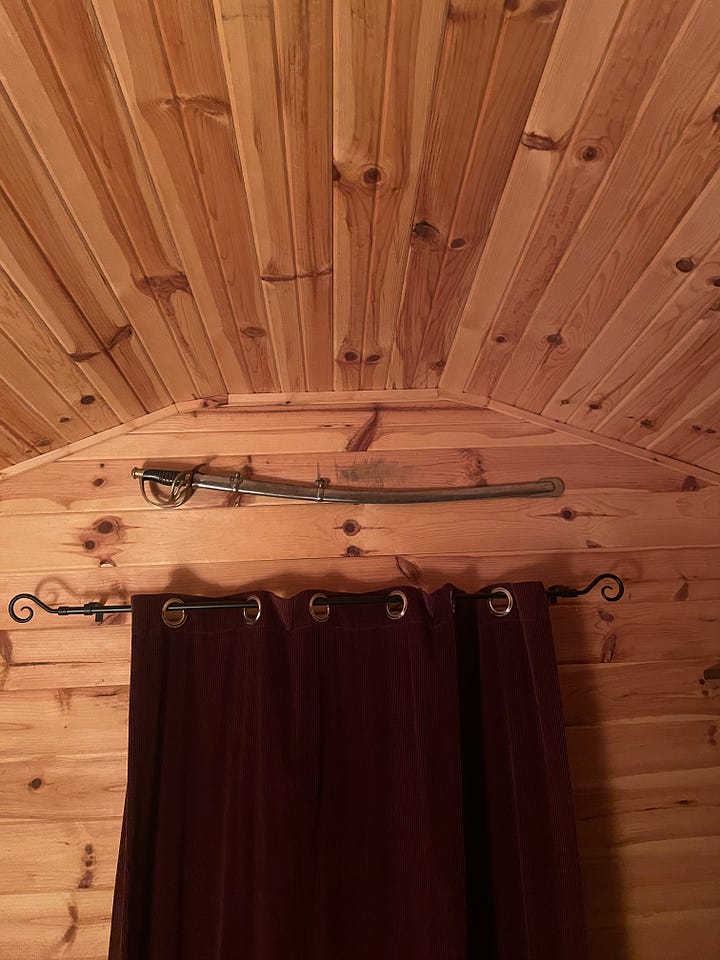“There is a deep human need for beauty, and if you ignore that need in architecture, your buildings will not last, since people will never feel at home in them.”
—Sir Roger Scruton
When I moved to my cottage last month, a small property on a lake two hours North of Toronto, I decided to convert the bunkie into my bedroom.
I liked the idea of having my own quiet cabin. A space I could retreat to, away from the hustle and bustle of the main cottage. A space I could take on the responsibility to improve, through effort and love. And live as if this simple room was my home forever, despite not knowing how long I’ll stay.
What I would only realize later: this bunkie was a test of my integrity to my ideal.
the foundation
A week before moving, I drove up to the cottage to look at the bunkie.
Bunk beds removed, I was left with an empty room. Raw pine walls, three windows that open wide, high ceilings, and a metal roof that rainfall turns into a soothing drum, it smelt like wood, felt like fresh air, and tasted of promise1.
I measured the space and drew a blueprint (roughly to scale) to determine the optimal layout2. Paying special attention to the windows, for what they carry into the room at different times of the day: sunlight and shadow, the amphitheater of birds and lapping of the lake, and airflow. I also thought hard about my own nature. What simple activities are important to me—writing, book discovery, reading before bed—and made sure they were incorporated in the design.


I wanted to create a beautiful but functional space. Utility without beauty is unimaginative, even soul-sucking, but beauty without utility is vain. It had to be both. Nothing could be ugly, everything had to serve a purpose.
Less conventionally, I chose to have two bookshelves rather than a bookshelf and a dresser (classic me). And, despite the small space, I wanted a desk. A designated workspace, sealed off from the world, where I can write every day.
On moving day, with all my stuff dumped in the room, there was work to be done…



I put my bed against the back wall, by the window nearest to the lake, and bolted the bed frame high to maximize storage. Then, I unpacked my seventeen boxes of books and sorted each book into its proper place. Finally, my trusty raise/lower desk. With dual monitors, a heavy metal lamp, a cast iron coaster, wood grain speakers, and a filing cabinet underneath (plus the nest of indistinguishable black cables).
The basics of the room were set. But, my work was far from over.


making things
With any project, problems arise that you never foresaw, yet soon become blindingly obvious.
Most of my clothes were in a bin under my bed but, without a closet, I had no place to hang anything. I already created a Pinterest board for the bunkie, to save images that matched the aesthetic and offered ideas for organization.
One night, I found a perfect shelf design.
The shelf had to adorn the room, add to the aesthetic. Yet most home improvement depots only sell sterile, utilitarian hardware and I refused to buy something comically careless. By a stroke of serendipity, I stumbled across a buy & sell store on the main street of a nearby town that carried cast iron hardware. It was unsymmetrical and clunky and perfect.
After measuring, cutting, sanding, and staining the pine board I bought at the lumber yard, I drilled in the three handles and fixed the shelf into the wall with two brackets3.







Around the same time, I was studying images of home offices and noticed a pattern: many of the most handsome offices had shelves perched on the wall facing out.
So I decided to make something similar, in the corner above my desk. It was a step up in difficulty, requiring a 45-degree cut and level brackets on separate walls, but not too difficult that it discouraged effort.





making it beautiful
To cultivate taste, I think you need exposure to a high volume of inputs that you then make positive or negative judgments about. Noticing the inputs that light you up, that make you feel something. Through repetition, you edge closer to your own aesthetic.
Images online are good, but paying attention during daily life is better4.
Out in the world, it’s worth noticing when I find beautiful places. To contemplate the elegant farmhouse or the delightful coffee nook or the charming floral wallpaper that catches my eye. To ponder what is meaningful in my surroundings. To learn what I find compelling and why.
It’s a commitment to a state of attention.




There is no formula for intimacy or coziness or even beauty. It wanders in the subconscious as an inarticulable but stubborn sensation. A conviction of “this is right” or “this is wrong,” without being able to explain why. Rooted in thousands of instantaneous and intuitive micro-decisions.
Beautiful spaces tend to have a quality that feels natural, even effortless. But they’re never a mistake. Beauty demands effort. Careful and patient and deliberate work.
My bunkie is adorned with art and various objects I’ve collected or made over the years. A hand-painted imitation of Van Gogh’s Café Terrace at Night, with its enchantingly vibrant blues and yellows. A SIMPLIFY sign I stenciled and spray painted on an old piece of barn wood I found in the basement. A Turkish coffee pot from Istanbul. Lots of books.




Each is a reminder of how I want to be in this world. Each I love dearly. Each found me, in its own way.
The stone Buddha was buried in a closet in an apartment I rented in downtown Toronto that the owner was thrilled to pass on. The carved lions were gifts, originally purchased from a boutique bookstore in the 80’s. I found the 17th-century French cavalry sword at some Western trading post in Illinois when I was 10 (and somehow convinced my parents to let me buy??). The statue of Moses I recognized in a local thrift store after I saw the real version, that Michelangelo spent 30 years carving, in the church of San Pietro in Rome.
I’ve found filling my life with beautiful things is such a low-hanging fruit way to improve my day to day.
I love what is imperfect, obscure, forgotten. Fallen through the cracks of our culture. Especially the handcrafted, the antiquated, the old5. Copper, stone, raw wood, corduroy. Patina. Unpolished surfaces. Textured colors. Ornamentation. Things that show wear—evidence of use, of life.
The details seem insignificant on their own, but details accumulate. The spiral ends of the curtain rod, the warm glow of an incandescent bulb, the wood casing on the light switch. They each twist my mood, however slight. If the details are wrong, the space feels awkward.
The magic of a home is its ability to generate moods and feelings. I get to shape the space, but then the space shapes me6.
Does it resemble a place of enchantment?
looking forward
Four weeks in, I’m satisfied with my progress but have a long list of improvements—more than I could possibly accomplish. Having one or two little projects I’m absorbed by is critical for my general well-being, and this bunkie provides a continuous supply.
I still have empty walls and shelf space, but I don’t want to just fill the room. I don’t want anything I’m tepid about.
Beauty cannot be rushed. Always, the most beautiful things are grown.
Yesterday, I cleaned off a 1940s amber-brown whisky bottle that was buried at the bottom of the lake, with a royal trademark stamp and embossed wrought iron gates, that I’ve filled with wildflowers. I’m hand-painting a sign with the word “LIGHTLY,” inspired by Aldous Huxley’s poem, to go above my desk7.
I want to replace my desk chair with something old and wood and doesn’t make me look like I grind League of Legends until 2am on Tuesdays8. And find a way to cover the fuse box—perhaps a Renaissance-style tapestry or a Navajo blanket. I’m making a stand for my laptop out of pine, instead of the cheap metal one I use.
Probably 80% of making a space beautiful is simply removing what is ugly. Not everything has to look good, but nothing can look bad. Inconsistency is hard on the eyes9.
The biggest learning from designing my bunkie has been the realization I can just do things. I don’t need permission or advice or special instruction. I can just find a space and make it beautiful. I can make shelves and hang art and forage for sacred things. I underestimated how easy, how close it was. How malleable the world is when I press my fingers into it. Agency—acting on my ideas, making an effort, reaching toward my ideal—feels like aliveness.
The world has a surprising amount of detail, but surprisingly few secrets.
My planned projects will all take time. The future changes will be less drastic, more gradual. But I’m cultivating patience along with my love and effort.
With the view in the morning, it'll be hard to go back.
Yours,
My essays are entirely funded by patrons. If you value my work and want to support it (and get some exclusive content), the best way is by taking out a paid subscription.
If you enjoyed this piece but are not ready to become a paid subscriber, you can Buy Me A Coffee. If you wish.
👋 what i’ve been up to:
Living, mostly
✍️ quote i’m pondering:
German filmmaker Werner Herzog on the sublime:
“I’m trying to find these rare moments where you feel completely illuminated.
Facts never illuminate you. The phone directory of Manhattan doesn’t illuminate you, although it has factually correct entries, millions of them. But these rare moments of illumination that you find when you read a great poem, you instantly know. You instantly feel this spark of illumination. You are almost stepping outside of yourself, and you see something sublime.”
Thank you for reading!
1- Leave a Like. If you enjoyed this post, please click the ❤️ below. It helps support my work (and keeps my dreams from drowning)
2- Spread some Love. If you want to make my day, share it with your people.
3- Get in Touch. If my writing resonates or if you need a friend, please reach out. Reply to this email or leave a comment :)
More walls should be windows.
With such a small space, there are tight constraints. However, I’ve found the best learning is always done within constraints.
I was surprised by the inconsistency of lumber. Many of the boards were warped or chipped and some were much prettier than others. It was worth taking time to go through the pile to find one of decent quality.
I’m restricting the scope to visual taste here, but taste extends far beyond what the eye can see. “There is taste in people, visual taste, taste in emotion,” Susan Sontag writes, “and there is taste in acts, taste in morality. Intelligence, as well, is really a kind of taste: taste in ideas”.
These objects tend to be surprisingly cheap, if you know where to look.
It seems almost everything was made with more thought, care, and intention 50-100 years ago. What is produced today that you may find in a second-hand store in 100 years? Everyone is thinking in days. No one is thinking in centuries.
Joseph Campbell often spoke about how the magic of a cathedral is the elevation in consciousness they invite. Inside sacred spaces, drenched with beauty, our mind ascends to contemplate higher things. The place pulls it out of us.
Beauty is a deep human need. Or else why would millions of people pilgrimage to Europe each year to gawk in museums and churches?
Somewhat related but super interesting, early cathedrals were designed to imitate forests. The rows of pillars and the stones of the vaulted ceilings resembled the trunks and branches of trees in a forest. The stained glass windows mirror how sunlight cuts through the branches.
Since ancient times, trees have been venerated for being associated with the gods. Forests were sacred spaces. “Trees were the first temples of the gods, and even now … we worship forests and the very silences they contain (Pliny the Younger).” Many churches were built on the sight of a sacred grove or nearby a particularly pious tree.
“It’s dark because you are trying too hard.
Lightly child, lightly. Learn to do everything lightly.
Yes, feel lightly even though you’re feeling deeply.
Just lightly let things happen and lightly cope with them.
I was so preposterously serious in those days, such a humorless little prig.
Lightly, lightly – it’s the best advice ever given me.
...
There are quicksands all about you, sucking at your feet,
trying to suck you down into fear and self-pity and despair.
That’s why you must walk so lightly.
Lightly my darling,
on tiptoes and no luggage,
not even a sponge bag,
completely unencumbered.”
― Aldous Huxley, Island
I will sacrifice some comfort for aesthetics here but it’s a trade I’m happy to make. I sit far too much anyway.
This is why the best photographs often have a consistent color palette.





I love how you can make something as mundane as moving sound so cathartic and beautiful as what you have written in this post.
1. I am SO jealous of your bunkie and the fact that you have a roof that amplifies the sound of the rain. Even when it is storming here in Toronto, the sound of the rain from sitting inside my apartment is non-existent and it is one of the things I dread most about the city.
2. I love what you mentioned at the end about the fact that you can just “do things”. That’s something that I have been realizing in passing moments as well - that I can literally do or make whatever I want to and that I don’t need permission, it doesn’t have to be perfect, and I don’t have to be an expert to try something new. Ideas of what to do or make are great but they don’t mean anything without giving them the time, effort and attention they deserve.
3. I think your footnotes might be even greater than the post itself
4. What do you mean you don’t grind League of Legends until 2 am????
As always, I loved reading your post.
Your friend,
Rachel
You have opened us all who read your words to the essence of "feng shui." Lovely, Tommy, lovely. Good for you! Creating an environment, to play in, to write in, that speaks to you through its beauty, that is meaningful, substantive...just like you.
There are two books by Christopher Alexander that I think you would love. When we created our home, my architect suggested we read them, and we did. They are "A Pattern Language" and "A Timeless Way of Building." They are soul siblings to your sensibilities.